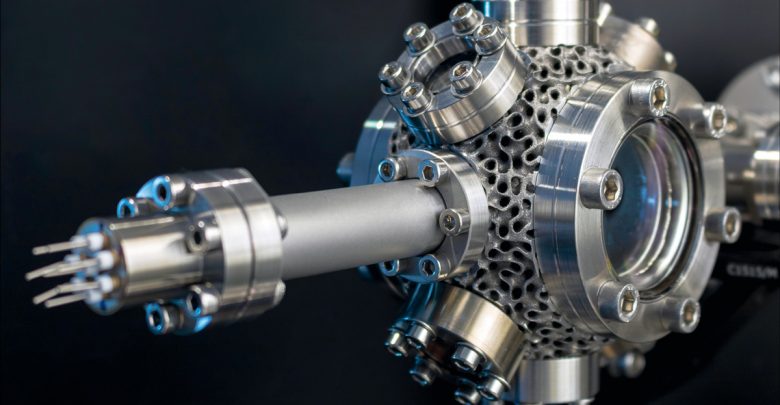Additive manufacturing R&D company Added Scientific has 3D printed the first vacuum chamber that can trap clouds of cold atoms. Introducing geometries only available to 3D printing, the vacuum system is significantly smaller and lighter than currently available chambers. This project paves the way for real-world quantum technology application such as building atomic clocks, essential for GPS, and gravimeters, used to sense tiny changes in local gravitational field.
Quantum technologies and vacuum systems
Isolating atoms from their environment and cooling them to near 0 K, quantum characteristics start to reveal themselves. This changes properties such as atom’s acceleration and rotation, the timing and frequency of transitions between energy levels, and even their responses to electromagnetic and gravitational fields. Exploiting these property changes, clouds of cold trapped atoms have been used to make quantum devices, like atomic clocks, tick.
However, forming and sustaining such clouds remain to be a technical challenge. Clouds require an ultrahigh-vacuum (UHV) environment of pressures below 7 – 10 pascals. UHV is essential for keeping the microkelvin atoms fixed in the trap and protected from the collisions with warmer particles in the atmosphere. Many cold-atom experiments such as ion trapping and making Bose-Einstein Condensates can only be carried out in UHV.
Currently, UHV assemblies consist of multiple bulky, standardized stainless-steel components. There is also a high risk of leaks due to the large number of vacuum connectors and joints between components. To take cold atoms out of the lab, the size and leakage problems of UHV subsystems have to be tackled.
Benefits of Additive Manufacturing
Dating back to 2017, Added Scientific’s project is a collaborative effort with research groups at the University of Nottingham and the University of Sussex. In the project, additive manufacturing allows truly bespoke designs that are optimized for the performance of UHV systems. Laurence Coles, computational research engineer at Added Scientific, explains, “[…] The flexibility that AM provides in terms of design freedom, part consolidation and added functionality suggests that there are now exciting opportunities to make wider and more significant changes in how we approach vacuum system design.”
Complex features such as internal channels and lightweight lattices can be created with AM. Several components can also be consolidated by AM into single parts while retaining all the features that would have traditionally required multi-part assembly, removing the need for vacuum joints.
Compared to using bulky off-the-shelf components, AM reduces the size, weight and power (SWAP) parameters of the entire system, ideal for applications of quantum technologies.
Geometry in chamber design
Identifying the potential of additive manufacturing, Added Scientific aims to build a vacuum chamber geared towards standard cold-atom experiments. Specifically, the team is constructing a magneto-optical trap (MOT) in which atoms are cooled and held in place with laser beams and magnetic fields.
Functional requirements of an MOT include a UHV environment, optical access for three orthogonal pairs of laser beams, space for magnetic coils and the ability to connect to standard components such as vacuum pumps.
Added Scientific’s chamber design consists of multiple ports with a thin layer of skin inside the wall to enable the chamber to hold the UHV. Alongside the chamber, the team also developed a magnetic coil forming insert with built-in water-cooling channels with additive manufacturing.
Geometry is the key to reduce mass of vacuum components while maintaining their structural integrity and stability. Keeping the chamber lightweight, the geometry of ports has to be refined to minimize the space inbetween. The team also incorporated symmetry in the chamber design, which is essential for minimizing optical transmission losses. A symmetrical chamber core ensures ports to remain perpendicular to the optical paths of laser beams.
A variable density triply periodic minimal surface lattice is added to the chamber core. Taking the form of a matrix-based gyroid surface, this lightweight structure is thickened to form a 3D geometry. These lattices balance the competing demands of increasing mechanical stiffness and minimizing mass. Increasing the chamber’s surface area-to-volume ratio, the lattice structure also accelerates heat dissipation.

Building the first AM UHV chamber
Added Scientific decided to build its vacuum chamber using an aluminium alloy AlSi10Mg produced by laser powder bed fusion. Other than high specific strength and low density, the material chosen has a characteristic ultrafine grain structure in which the grains grow up through the layers as the component is built. Heat treatments are applied to enhance the material’s strength for the use of knife-edge sealing techniques. This step also relieves residual stresses built up due to the 3D printing process.
Traditionally manufactured UHV components have a machined and polished internal surface finish. In contrast, AM metals have rough surfaces, unfavourable for high risk of outgassing. To test if the AM alloy is suitable for UHV, the team conducted X-ray photoelectron spectroscopy (XPS) and mass spectrometric study. A protective magnesium-rich oxide layer that suppresses outgassing was found on the surface. The validity of using AM alloys in vacuum applications was well supported by the test results.
Moving on, the team assessed the vacuum performance of the AM chamber. The 3D printed vacuum chamber was mounted to off-the-shelf stainless-steel viewports and components, forming a complete vacuum assembly. Afterwards, the entire system was heated to 120 °C for 120 hours. Once ‘baked’, the UHV was sustained using a combined ion/non-evaporable getter (NEG) pump. In the end, the chamber reached a final pressure within the UHV range, successfully achieving and sustaining the magneto optical trapping of rubidium atoms.
Further testing was done at the National Quantum Technologies Showcase event in London. Travelling all the way from Nottingham, the chamber was without external power or active pumping for 48 hours. The pressure rose only to 7 – 10 pascals with just passive NEG pumping in place – still sufficiently low for cold rubidium atoms to be captured and retained in a MOT.

Go smaller or go home
Through additive manufacturing optimized design and the use of new materials, the mass of Added Scientific’s prototype MOT chamber is only 245 g. Compared to its commercially available stainless-steel equivalent, the prototype weighs 70% less. On top of saving precious lab space, the AM MOT chamber greatly enhances the portability of future quantum devices.
“So far, quantum physics is one of the few fields where customers are really pushing for smaller UHV systems,” Coles comments, “This makes projects like the additively manufactured MOT chamber a perfect testbed for AM within the vacuum industry.”
Now, Added Scientific is working towards even smaller AM vacuum chambers.In principle, the minimum size of a MOT is determined by the diameter of the orthogonal laser beams that enter its windows and provide its optical trapping element. The need to integrate the AM chamber with existing, off-the-shelf vacuum components hinders the team to reach the theoretically smallest size.
In the next iterations of the UHV chamber, SWAP parameters will be further reduced by overcoming this limitation and designing with the wider vacuum system in mind. Suggested by the experimental results, Added Scientific will also attempt to reach conditions required for Bose-Einstein Condensation.
As for applications, the team aims to deliver its technology into quantum devices such as atomic clocks and gravimeters in the near future. “[…] This technology could have applications in any device / equipment that utilise UHV systems and may include quantum computing also, as well as others outside of quantum such as XPS for example,” Coles adds.
Additive manufacturing makes vacuum systems smaller, lighter and smarter first appeared in the 2019 Physics World Focus on Instruments & Vacuum. The article in Physics World Focus is written by Laurence Coles.
For all of the latest additive manufacturing research news subscribe to our newsletter, follow us on Twitter, and like us on Facebook. Find talent for a project, or advance your career in 3D printing – join 3D Printing Jobs to apply and advertise.



